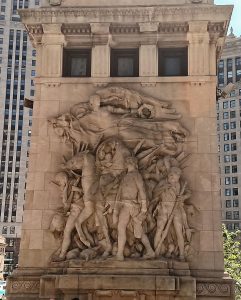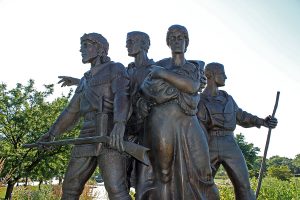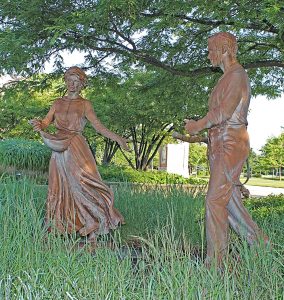Chicago, Illinois

In the 19th century, Chicago served as a shipping hub that connected the western United States to the eastern seaboard. In contrast to rival Kansas City, 20th-century Chicagoans demonstrated relatively little interest in identifying themselves as western by erecting pioneer monuments. James Earle Fraser (best known for his End of the Trail depicting Indian subjugation) sculpted a pioneer-themed relief as one of four large sculptural adornments to the DuSable (Michigan Avenue) Bridge in downtown Chicago. But no large pioneer monuments appeared in Chicago during the 20th century. But in recent years, erecting pioneer-themed sculpture has become a means for Chicago’s postwar suburbs to claim their 19th-century roots and to compete for tourist dollars.
Elgin, Illinois

In 2001, Elgin, Illinois, erected a sculpture by native son Trygve A. Rovelstad that the artist first designed for his hometown in the 1930s. But fundraising efforts floundered amid the Great Depression and beyond. While neighboring towns boomed with new suburban subdivisions after World War II, Elgin struggled to regain the regional prominence it enjoyed as a 19th-century manufacturing center. Only after riverboat gambling arrived in Elgin did the local economy rebound enough to support the redevelopment of the city’s riverfront and the bronze casting of Rovelstad’s life’s work.
Schaumburg, Illinois

Postwar housing construction — combined with new freeways and expansion at nearby O’Hare Airport — transformed neighboring Schaumburg from a tiny village to a large suburb best known for its shopping mall. In an effort to combat Schaumburg’s vanilla image, the town built a New Urbanist town center intended to resemble a New England town square. It purchased David Alan Clark’s Spirit of the Prairie to adorn its new pond and amphitheater.
Interactive Map and Timeline: Chicago Area
Drag the timeline to see the monuments erected over time.
Click on a marker on the timeline or the map to learn more about that monument.
Search an artist’s name or browse by era or design to highlight related monuments on the timeline and map.